ELECTRIC VEHICLE: charging
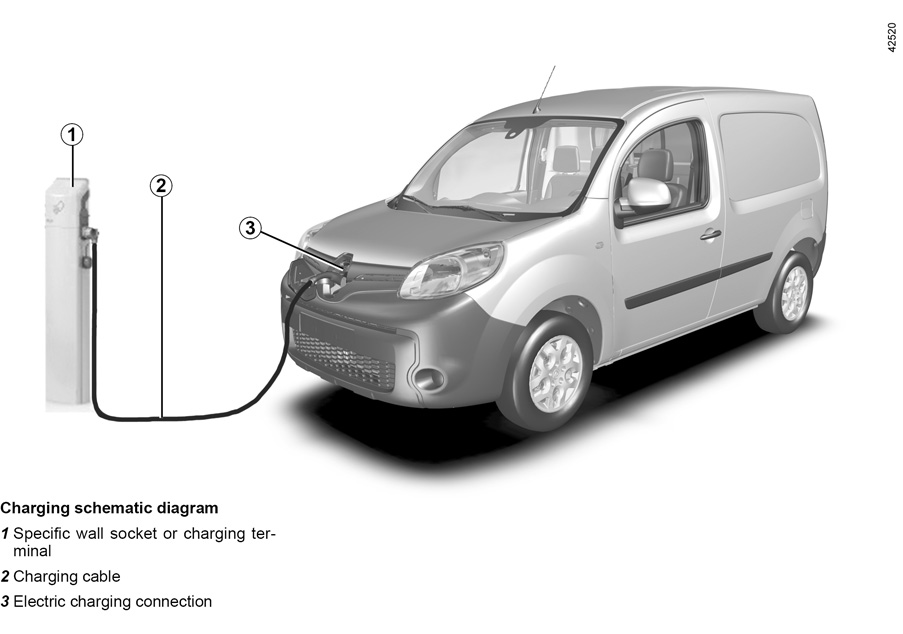
If you have any questions regarding the equipment needed for charging, please ask an authorised dealer.
Important recommendations for charging your vehicle
Please read these instructions carefully. Failure to follow these instructions may lead to a risk of fire, serious injury or electric shocks which could result in death.
Charging
Do not do anything to the vehicle during charging (washing, working in the engine compartment, etc.).
In the event of the presence of water, signs of corrosion or foreign bodies in the charging cord connector or in the vehicle charging socket, do not charge the vehicle. Fire hazard.
Do not attempt to touch the cord contacts, the domestic socket or the vehicle charging socket, or introduce objects into them.
Never plug the charging cord into an adapter, multiple socket or extension lead.
The use of generators is prohibited.
Do not remove or change the vehicle charging socket or the charging cord. Fire hazard.
Do not modify or perform any action on the installation during charging.
In the event of an impact, even slight, against the charging socket or valve, have them checked by an authorised dealer as soon as possible.
Take care of the cord: do not tread on it, immerse it in water or pull on it or let anything knock against it.
Check regularly that the charging lead is in good condition.
In the event of damage to the charging lead (corrosion, browning, cuts, etc.), to the unit or to the vehicle's electrical charging socket, do not use them. Please see an authorised dealer to replace them.
In the event of non-activation of the charging flap locking mechanism and/or unlocking of the vehicle's electric charging socket, please contact an approved dealer.
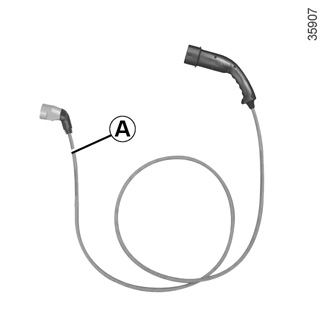
Charging cable A
This lead is specific to your vehicle and designed for connecting to wall sockets or public terminals to enable standard charging of the traction battery.
We recommend that you use a charging cord that enables a standard charge to charge the traction battery.
Each charging lead is stored in the luggage compartment of the vehicle.
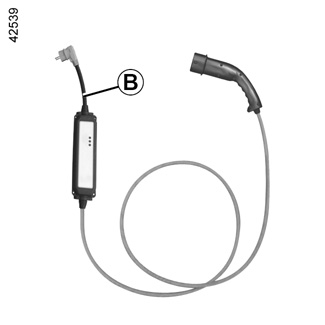
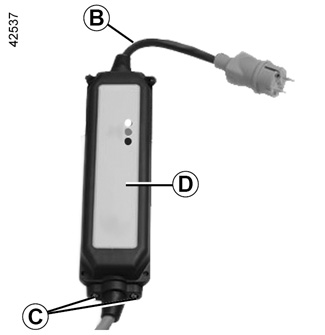
Charging cable B
This cord allows:
- standard charge, on a socket used only for the vehicle (14 A charge);
- occasional charge using a domestic socket, (10 A charge) when you are not at home, for example.
Sockets must be fitted as stated in the instructions in the instructions supplied with the charging cord B.
Always read the charging cable instructions carefully before using it B.
Never leave the socket hanging by the cord. Use the hooks C to attach it.
If a charging cable malfunctions during the charging process (red warning light on the unit D), stop charging immediately. Please refer to cord instructions.
Important recommendations for charging your vehicle
Please read these instructions carefully. Failure to follow these instructions may lead to a risk of fire, serious injury or electric shocks which could result in death.
Choice of charging cord
The standard charging leads supplied with the vehicle have been designed specifically for use with this vehicle. It is designed to protect you against the risks of electric shock that can lead to death or fire.
Do not use with the charging leads of previous vehicles as they are not adapted. For safety reasons, the use of a charging cord not recommended by the manufacturer is strictly forbidden. Failure to follow this instruction can lead to risks of fire or electric shock that can prove fatal. For information on a charging cord suited to your vehicle, please consult an authorised dealer.
Using the charging lead B
Please read the instructions that come with the charging cord carefully to learn about precautions you must take when using the product and the technical specifications required when fitting the socket.
Installation
Power supply systems
Only use charging terminals which conform to the IEC 61851-1 standard and connecting points protected by:
- a type A 30 mA residual differential current system specific to the socket used;
- an overcurrent protection device;
- protection against overvoltage relating to lightning in exposed areas (IEC 62305-4).
Wall socket
Have a special wall socket installed by a qualified professional.
In the case of domestic charging
Have a qualified professional check that each socket to which you will connect the charging cord complies with the standards and regulations in force in your country and that it complies with the specifications described previously in the information on “Power supply systems”.
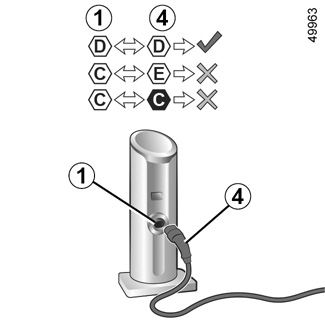
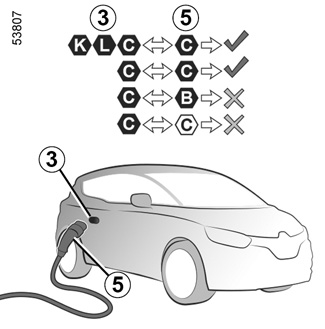
Charging types that conform to European standards
Alternating current (AC)
If the information is displayed on the vehicle charging flap, follow the instructions below.
Before plugging in a charging lead, check that:
- the colour and one of the letters of the charging terminal inlet socket 1 correspond to the colour and one of the letters at the end 4 of the cable;
- the colour and one of the letters of the inlet socket 3 correspond to the colour and one of the letters on the end 5 of the lead.
Charging type | Alternating current (AC) | ||||
|---|---|---|---|---|---|
Connection | Charging terminal 1/Charging lead 4 | Vehicle 3/Charging lead 5 | |||
Charging types that conform to European standards (for all other cases, please consult an approved dealer). |
|
|
|
|
|
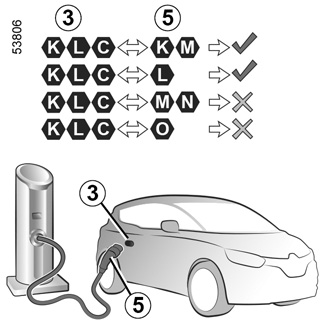
Charging types that conform to European standards (continued)
Direct current (DC)
If the information is displayed on the vehicle charging flap, follow the instructions below.
Before plugging in a charging lead, make sure that the colour and one of the letters of the inlet socket 3 correspond to the colour and one of the letters on the end 5 of the charging lead.
Charging type | Direct current (DC) | ||||
|---|---|---|---|---|---|
Connection | Vehicle 3/Charging lead 5 | ||||
Charging types that conform to European standards (for all other cases, please consult an approved dealer). |
|
|
|
|
|
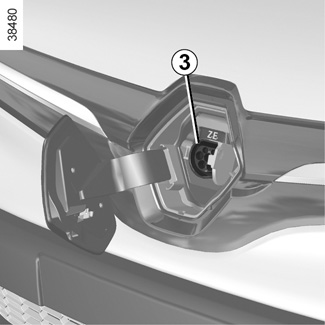
Charging connection 3
The vehicle has a charging connection located at the front of the vehicle.
Precautions
Avoid charging and parking your vehicle in extreme temperatures (hot or cold).
When the vehicle is parked in temperatures lower than around -25°C, the battery cannot be charged.
To preserve the service life of your traction battery, avoid parking the vehicle for more than three months with high charge, especially when the weather is very hot.
You must charge the traction battery after driving in very cold weather. Otherwise, charging may take a longer period of time or even become impossible.
Recommendations
- In extreme heat, favour parking and recharging the vehicle in a shaded/covered location.
- Charging can be performed in the rain or snow.
Note: If in a snowy environment, remove snow from the vehicle charging area before plugging in or disconnecting. Snow in the socket may block the insertion of the charging cord plug.
In the absence of any protection against overvoltage, you are recommended not to charge the vehicle in stormy weather (lightning, etc.).
The traction battery charging time depends on the amount of energy remaining, the power delivered by the charging terminal and the temperature conditions (hot or cold). The information is displayed on the instrument panel during charging. Please see the information on “Displays and indicators” in Section 1.
In the event of a problem, we recommend that you replace it with an identical cord. Please see an authorised dealer.
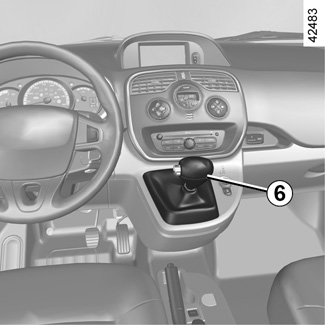
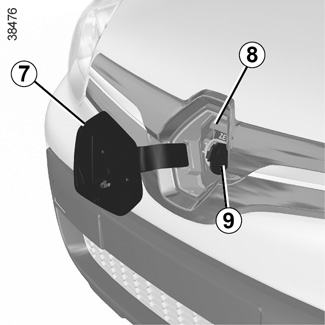
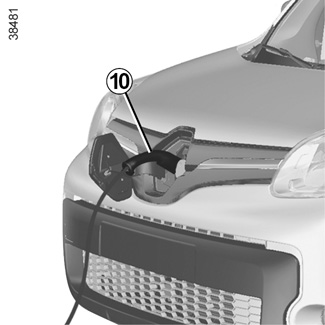
Recharging the traction battery
With the ignition off, lever 6 in gear P and opening elements unlocked:
- take the charging cord located in the boot of your vehicle;
- remove it from its storage bag;
- plug in the end of the cord to the power supply (terminal, domestic plug socket, etc.);
- open the charging flap 7;
- open valve 9;
- grab the handle 10;
- plug in the vehicle cord;
- make sure you have clicked the charging cable in properly. The ṋ warning light on the instrument panel comes on, and the Z.E. 8 blue warning light comes on, then flashes rapidly.
The charging cord cannot be plugged in or removed while the opening elements are locked.
Make sure you fully uncoil the charging cord to limit its heating.
Do not use an extension lead, multiple socket or adapter.
Fire hazard.
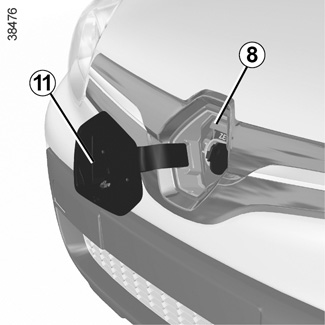
The charging cord is automatically locked with the vehicle. This will make it impossible to unplug the cord from your vehicle.
When charging commences, the hazard warning lights will flash five times. A message on the instrument panel indicates the remaining charging time and the Z.E. 8 warning light flashes slowly.
At the end of a full charge, the Z.E. 8 warning light will remain blue then go out after several minutes.
You do not need to wait until the charge is at reserve levels to recharge your vehicle.
If the Z.E. 8 warning light lights up red, the vehicle cannot start charging; restart the charging procedure.
If the problem persists, change power supply (terminal, etc.) or consult and approved Dealer.
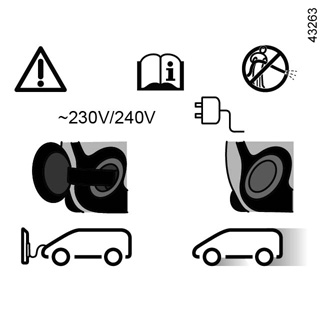
Label 11
The label 11 on the charging flap reminds you of the instructions for the opening and closing of the flap:
- with the vehicle stationary, the valve and the charging flap can be open;
- when the vehicle is being driven, the valve and the charging flap must be closed.
To avoid disturbing the charging monitoring system, do not install any antistatic strip to the vehicle.
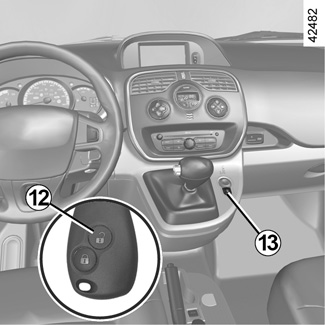
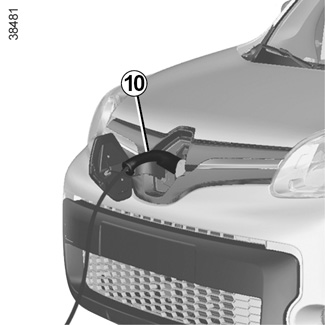
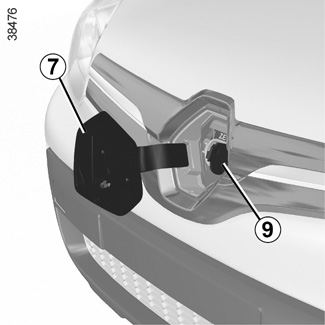
Precautions to take when removing from the socket
- Press the button 12 on the radio frequency remote control or switch 13 to release the charging cable;
- grab the handle 10;
- unplug the charging cable from the vehicle. Warning light ṋ goes out on the instrument panel;
- close valve 9;
- close the charging flap 7;
- unplug the cord from the power supply;
- store the cord in its storage bag and put away in the boot.
Note: immediately after a long charge of the traction battery, the cable may be hot. Please use the handles.
After pressing the charging cord release button, you will have around 30 seconds to unplug it before it is locked once again.
It is imperative to follow the unplugging steps in order.









